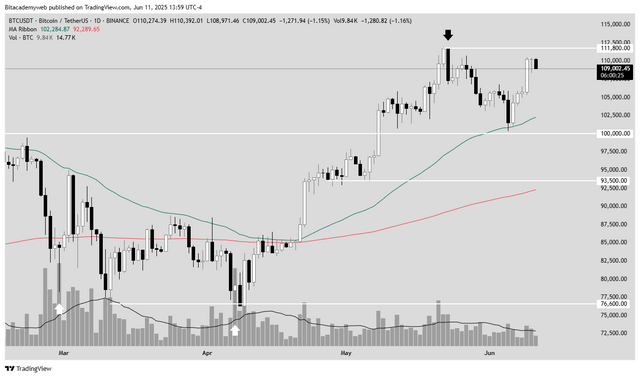Bitcoin Stagnates at $109,000 After Inflation Data
The king of cryptocurrencies faces crucial resistance as the market's eyes focus on the Fed and an imminent rate cut.
Bitcoin's price was rejected from the $111,800 resistance, retreating slightly to $109,002 with a loss of 1.15% at the time of this report, despite inflation in the United States, although up, coming in lower than expected. Macroeconomic uncertainty and high open interest are generating pressure, while most Bitcoin addresses are in profit, encouraging profit-taking.

Bitcoin price was rejected from the resistance at $111,800, retreating slightly to $109,002 with a loss of 1.15% at the time of this report / TradingView
US Inflation: A Sigh of Relief, But Is It Enough for Bitcoin?
Annualized inflation in the United States came in at 2.4%, slightly below the consensus of 2.5%, but still higher than the 2.3% of the previous month. This figure, although downward trending, remains above the Federal Reserve's (FED) 2% target.
What does this figure mean for the economy and Bitcoin?
Lower-than-expected inflation figures can be interpreted as a sign that inflationary pressures are easing. This, in theory, could give the FED more room to ease its monetary policy. For Bitcoin and other risk assets, controlled inflation is generally a favorable scenario, as it lessens pressure on the FED to maintain a restrictive stance that could discourage investment in non-traditional assets. However, the fact that the 2% target has not yet been reached generates caution and does not provide a decisive boost to the price.
The Fed in Focus: Stable Rates and the Wait for September
In the federal funds futures market, expectations are almost unanimous: 99.9% of traders are betting that the Fed will keep the interest rate unchanged at 4.50% in its next FOMC announcement on June 18. The focus is on a possible first rate cut in September, with a 58.6% probability.
Why would the Fed keep rates steady and how does it affect Bitcoin?
The Fed will likely keep rates steady to assess the impact of its current monetary policy on the economy and inflation. A premature rate cut could reignite inflationary pressures. For Bitcoin, keeping rates unchanged means that the opportunity cost of holding risky assets does not decrease significantly. Investors can still opt for safer investments with guaranteed returns. A future rate cut, on the other hand, would inject liquidity into the financial system and could boost interest in riskier assets like Bitcoin by making other investments less attractive.
Market Pressure: Liquidity, Profits, and Opportunity Selling
Bitcoin's price is under pressure not only from macroeconomic expectations but also from the high liquidity that has entered through open interest (OI) in recent weeks, which has contributed to its recent rise. Under these circumstances, some investors are choosing to take profits. BTC's OI-weighted funding rate is 0.0062%, according to data from Coinglass.
A relatively high funding rate indicates that traders holding long positions (betting on a price increase) are paying short traders (betting on a price decrease). While this can be a sign of strong bullish sentiment, it can also incentivize some traders to close their long positions to avoid paying these fees or to capitalize on profits already made. It's a sign that the market could be overheated and prone to a correction.
In the current climate, with sensitive macroeconomic data and a bull market, many BTC traders are taking profits. On-chain data from Bitcoin Magazine Pro reveals that the percentage of Bitcoin addresses in profit is an impressive 99.58%.
What could happen when almost all Bitcoin addresses are in profit?
When the vast majority of Bitcoin addresses are in profit, it creates a strong incentive for profit-taking. Traders who bought at lower prices see their investments profitable and may decide to sell some or all of their holdings to lock in those profits. This can generate significant selling pressure in the market, which in turn could lead to a short-term price correction, even if overall sentiment remains bullish over the long term. This is a time when the market becomes more sensitive to any negative news or data, as many are ready to execute sales.
Technical Analysis: Bullish Sentiment with Warnings
Although BTC remains below the crucial resistance of $111,800, overall market sentiment remains bullish, trading above the EMA50 and EMA200. However, Bitcoin's latest rally lacked sufficient momentum, as the increase occurred in divergence with trading volume.
What does it mean when the price rises with low trading volume?
A price increase with low trading volume is a warning sign for technical analysts. It indicates that the upward movement is not being supported by significant buying interest. In other words, few market participants are driving the price higher, making the rally less sustainable and more likely to reverse. In a healthy market, bullish price movements should be accompanied by an increase in trading volume, which would confirm the strength of the trend. In this case, the lack of volume suggests that the rejection at the resistance could be more significant.
The Bitcoin market is at a crossroads, grappling with the key resistance at $111,800 and macroeconomic caution. While bullish sentiment persists, signs of potential profit-taking and a flat rally call for caution. The Fed's next decision will be key in determining the short-term trajectory of the leading cryptocurrency.
Disclaimer: This article is for informational purposes only and does not constitute financial advice. Investing in cryptocurrencies involves risks.
Upvoted! Thank you for supporting witness @jswit.